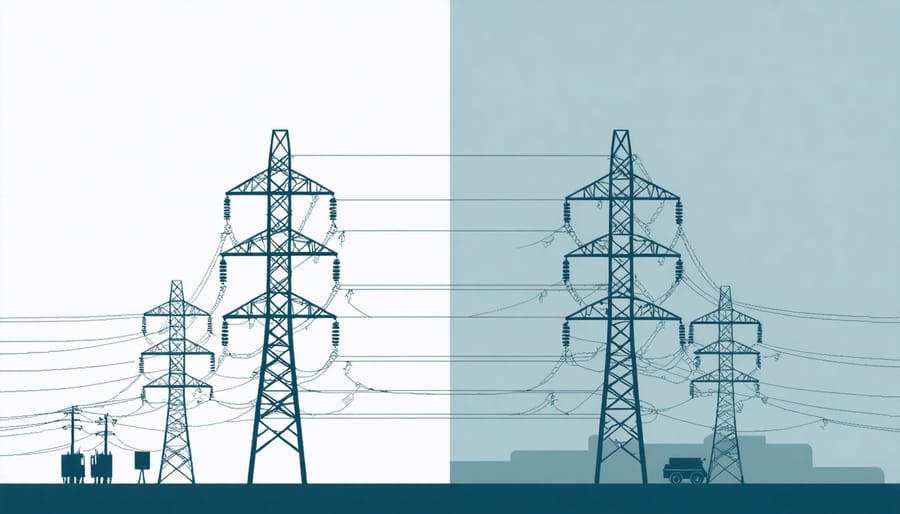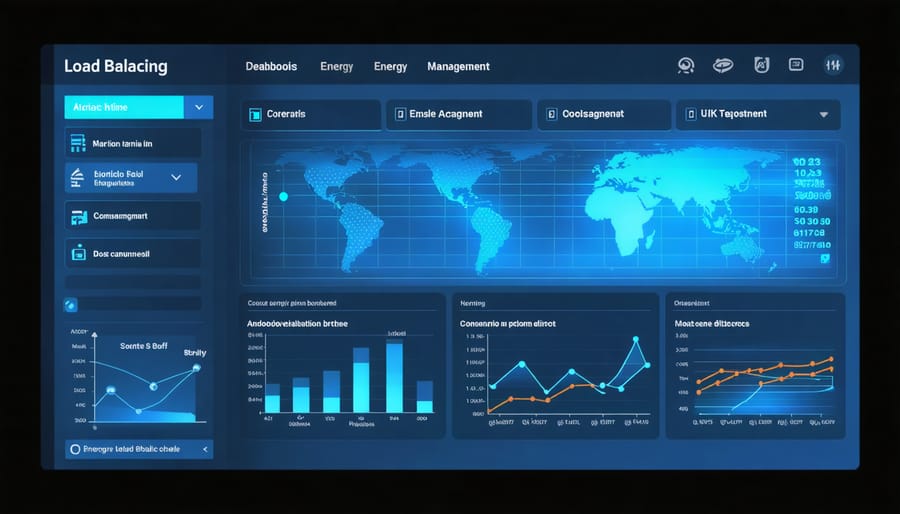Smart grid technology is revolutionizing the construction industry’s approach to energy management, offering unprecedented control over power distribution, consumption, and efficiency. This intelligent network infrastructure combines advanced sensors, automated controls, and data analytics to create a responsive, self-healing power delivery system that adapts in real-time to changing energy demands and conditions.
For construction professionals and project stakeholders, smart grid implementation represents a critical advancement in building infrastructure development. By integrating renewable energy sources, optimizing load distribution, and enabling two-way communication between utilities and end-users, smart grids are transforming how we design, construct, and operate modern buildings and facilities.
Recent industry data indicates that smart grid technologies can reduce energy costs by up to 30% while improving grid reliability by 40%. These systems are particularly vital for large-scale construction projects, where power management directly impacts project timelines, operational costs, and long-term sustainability goals.
As the construction sector continues to embrace digital transformation, understanding and implementing smart grid solutions has become essential for industry leaders seeking to deliver future-ready, energy-efficient buildings. This comprehensive analysis explores the technical requirements, implementation strategies, and economic benefits of smart grid integration in construction projects.
The Evolution of Smart Grid Technology in Construction
Traditional vs. Smart Grid Systems
Traditional power grids operate on a one-way distribution model, where electricity flows from centralized power plants to end users through a hierarchical network of transmission and distribution lines. In contrast, modern smart grid systems employ bi-directional communication and power flow, enabling real-time monitoring, automated response, and distributed energy integration.
While conventional grids rely on manual intervention for fault detection and load balancing, smart grids utilize advanced sensors, meters, and control systems to automatically identify and resolve issues. These intelligent networks can instantly reroute power during outages, optimize distribution based on demand patterns, and seamlessly integrate renewable energy sources.
Traditional infrastructure struggles with peak load management and often requires significant overcapacity to maintain reliability. Smart grids, however, implement demand response programs and dynamic pricing mechanisms to balance load more efficiently. They also enable advanced features such as self-healing capabilities, predictive maintenance, and integration with building management systems, significantly reducing downtime and operational costs while improving overall grid reliability and sustainability.

Key Components of Smart Grid Infrastructure
A smart grid infrastructure comprises several interconnected components that work together to create an efficient and responsive energy distribution system. At its core, Advanced Metering Infrastructure (AMI) enables two-way communication between utilities and end-users, providing real-time consumption data and enabling dynamic load management.
Smart sensors and monitoring devices throughout the grid network continuously collect data on power quality, equipment status, and system performance. These are complemented by automated distribution systems that can reroute power flows and self-heal during outages.
Energy storage systems, including battery banks and thermal storage units, play a crucial role in balancing supply and demand while integrating renewable energy sources. Advanced communication networks, utilizing both wireless and fiber-optic technologies, form the backbone of the system, enabling seamless data exchange between components.
Control centers equipped with sophisticated energy management systems (EMS) process this data, making real-time decisions to optimize grid performance. Smart inverters and power electronics help manage bidirectional power flow, essential for incorporating distributed energy resources like solar panels and wind turbines into the grid infrastructure.
Smart substations featuring automated switching and protection systems ensure reliable power distribution while maintaining grid stability and security.
Real-Time Energy Management Benefits

Demand Response and Load Balancing
Demand response and load balancing represent critical components of modern building energy management systems, enabling intelligent distribution of power resources across the grid. Through advanced metering infrastructure (AMI) and automated control systems, smart grids can dynamically adjust energy consumption patterns to match available supply and optimize grid stability.
During peak demand periods, smart grid systems automatically implement load-shedding strategies, redirecting power from non-essential services to critical operations. This intelligent load management helps prevent grid overload while maintaining essential services. Commercial buildings can participate in demand response programs, receiving financial incentives for reducing consumption during high-demand periods.
Real-time monitoring and predictive analytics enable grid operators to anticipate consumption patterns and adjust accordingly. For instance, during extreme weather events, smart grids can automatically adjust HVAC systems across multiple buildings to prevent simultaneous peak demands. This coordinated approach ensures grid stability while maintaining occupant comfort.
The system’s ability to integrate renewable energy sources further enhances load balancing capabilities. When solar or wind generation increases, smart grids can automatically adjust consumption patterns to maximize the use of these sustainable resources, reducing reliance on conventional power plants and improving overall grid efficiency.
Cost Optimization and Energy Efficiency
Smart grid implementation delivers substantial financial benefits through enhanced energy management and operational efficiency. Studies show that organizations can achieve 15-25% reduction in energy costs through smart grid adoption, primarily through demand response programs and real-time consumption monitoring.
The system’s ability to automatically adjust power distribution based on peak usage periods enables significant cost savings. During high-demand periods, smart grids can redistribute power loads, preventing costly demand charges while maintaining operational efficiency. This dynamic load management capability typically results in a 20% decrease in peak demand charges.
Advanced metering infrastructure (AMI) provides precise usage data, allowing facility managers to identify energy waste and optimize consumption patterns. Real-world implementations demonstrate that data-driven decision-making leads to an average 30% improvement in energy efficiency across commercial buildings.
Organizations can also benefit from participation in utility incentive programs. Smart grid-enabled buildings can automatically respond to utility signals, earning credits or reduced rates for participating in demand response events. Case studies from commercial implementations show annual savings of $0.50-$1.50 per square foot through these programs.
The integration of renewable energy sources becomes more economically viable with smart grid technology. The system’s ability to balance variable renewable generation with building demand reduces dependency on grid power during peak rate periods, resulting in additional cost savings of 10-15% annually.
Maintenance costs are also reduced through predictive analytics and automated system monitoring, with most facilities reporting a 25% decrease in maintenance-related expenses after smart grid implementation.
Implementation Strategies and Challenges
Integration with Building Management Systems
The integration of smart grids with building management systems (BMS) represents a critical junction in modern construction technology, enabling seamless communication between power distribution networks and facility operations. This integration primarily occurs through advanced protocols such as BACnet, Modbus, and KNX, which facilitate real-time data exchange between smart grid components and building automation systems.
Key to successful integration is the implementation of gateway devices that serve as intermediaries between the smart grid and BMS platforms. These gateways translate various communication protocols and ensure smooth data flow, enabling buildings to respond dynamically to grid conditions and energy pricing signals.
Modern building management systems incorporate smart meters, submeters, and IoT sensors that continuously monitor energy consumption patterns. This infrastructure allows for automated load shedding during peak demand periods and optimal utilization of on-site renewable energy sources. The system can automatically adjust HVAC operations, lighting levels, and other power-intensive systems based on grid conditions and energy costs.
Cloud-based integration platforms have emerged as powerful tools for managing the complex interaction between smart grids and building systems. These platforms provide centralized control, data analytics, and predictive maintenance capabilities while ensuring cybersecurity protocols are maintained throughout the network.
For existing buildings, retrofitting options include installing smart controllers and upgrading legacy systems with modern communication modules. This approach allows older facilities to participate in demand response programs and benefit from smart grid capabilities without requiring complete system replacement.
Integration success depends heavily on proper system architecture design and careful consideration of scalability requirements. Engineers must ensure that the chosen integration method supports future expansions and technological updates while maintaining system reliability and security.
Addressing Security and Reliability Concerns
Maintaining the security and reliability of smart grid systems requires a multi-layered approach combining robust cybersecurity measures with physical infrastructure protection. Advanced encryption protocols and secure authentication mechanisms form the foundation of data protection, ensuring that sensitive information remains safeguarded during transmission between grid components.
Real-time monitoring systems equipped with artificial intelligence capabilities can detect and respond to potential security breaches instantaneously. These systems analyze patterns in grid behavior, flagging anomalies that might indicate cyber attacks or system failures. Implementation of redundant communication channels and backup power systems ensures operational continuity even during security incidents.
Physical security measures, including surveillance systems and access control protocols, protect critical infrastructure components from unauthorized access. Regular security audits and vulnerability assessments help identify potential weaknesses before they can be exploited. Construction professionals must ensure that security considerations are integrated into the initial design phase rather than treated as an afterthought.
Industry standards such as IEC 61850 and IEEE 2030 provide frameworks for secure smart grid implementation. Compliance with these standards, combined with regular staff training on security protocols, significantly reduces vulnerability risks. Automated failsafe mechanisms can isolate compromised sections of the grid, preventing cascading failures that could affect entire networks.
Disaster recovery plans and regular backup procedures ensure quick system restoration in case of security breaches or technical failures. Construction firms should maintain detailed documentation of security protocols and establish clear communication channels with utility providers and security response teams. This comprehensive approach to security and reliability helps maintain system integrity while fostering stakeholder confidence in smart grid technology.
Future Prospects and Industry Trends
AI and Machine Learning Applications
Artificial Intelligence and machine learning technologies are revolutionizing smart grid operations, offering unprecedented capabilities in grid optimization and management. AI and machine learning in energy management systems enable real-time analysis of vast amounts of data from connected devices and sensors, facilitating predictive maintenance and demand forecasting with remarkable accuracy.
These advanced technologies employ sophisticated algorithms to analyze consumption patterns, weather data, and grid performance metrics, enabling automated load balancing and optimal energy distribution. Machine learning models can predict equipment failures before they occur, reducing downtime and maintenance costs while improving overall grid reliability.
Smart grid AI applications include autonomous fault detection systems that can identify and isolate grid disruptions within milliseconds, preventing cascading failures and maintaining grid stability. Deep learning algorithms optimize power flow across the network, reducing transmission losses and improving energy efficiency.
Recent implementations have demonstrated up to 25% improvement in grid operational efficiency through AI-driven optimization. The technology enables dynamic pricing strategies based on real-time demand and supply conditions, encouraging efficient energy consumption patterns among end-users while maintaining grid stability during peak demand periods.
For construction professionals, these innovations translate into more reliable power systems, reduced operational costs, and enhanced building performance monitoring capabilities.
Renewable Energy Integration
Smart grids play a pivotal role in enabling effective renewable energy integration within modern construction projects. These sophisticated systems utilize advanced monitoring and control technologies to manage the variable nature of renewable energy sources, ensuring stable power distribution and optimal resource utilization.
The integration capabilities of smart grids extend beyond simple power distribution. They incorporate intelligent load balancing, real-time demand response, and automated switching between different energy sources. When solar panels generate excess power during peak sunlight hours, smart grids can automatically redistribute this energy to high-demand areas or store it in battery systems for later use.
Advanced metering infrastructure (AMI) within smart grids enables bidirectional communication between energy producers and consumers, facilitating precise monitoring of energy generation and consumption patterns. This data-driven approach allows building managers to optimize energy usage and maintain grid stability despite the intermittent nature of renewable sources.
Recent implementations have demonstrated that smart grids can increase renewable energy utilization by up to 30% while reducing grid instability issues by 40%. These systems also enable dynamic pricing models, encouraging energy consumption during periods of abundant renewable generation and promoting more sustainable building operations.
For construction professionals, understanding these capabilities is crucial when designing and implementing modern energy systems that maximize renewable resource potential while ensuring reliable power supply.

The evolution of smart grid energy represents a pivotal transformation in modern construction and infrastructure development. As we’ve explored throughout this article, smart grids offer unprecedented opportunities for energy efficiency, cost reduction, and sustainable building operations. The integration of advanced metering infrastructure, renewable energy systems, and intelligent energy management platforms has proven to be a game-changer for construction professionals seeking to deliver future-ready buildings.
Industry trends indicate that smart grid adoption will continue to accelerate, driven by technological advancements in IoT sensors, artificial intelligence, and energy storage solutions. Construction firms that embrace these innovations now will be better positioned to meet increasingly stringent energy regulations and growing client demands for sustainable buildings.
Looking ahead, we can expect to see greater integration of blockchain technology for secure energy transactions, enhanced predictive maintenance capabilities, and more sophisticated demand response systems. The convergence of 5G networks and edge computing will further revolutionize grid management, enabling real-time decision-making and improved grid resilience.
For construction professionals, the key to success lies in developing comprehensive smart grid strategies that balance initial investment costs with long-term benefits. This includes careful consideration of system scalability, interoperability with existing infrastructure, and ongoing maintenance requirements. As smart grid technology continues to mature, staying informed about emerging solutions and best practices will be crucial for delivering competitive advantages in the construction industry.

